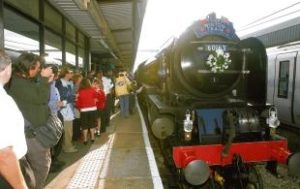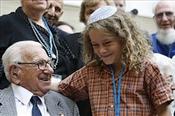Lunch overlooking the sea at Kibbutz Lavi was a culinary and scenic delight. The religious-Zionist kibbutz in the lower Galilee was established in 1949 by a youth organization from England, many of whom had escaped the Holocaust through the kindertransport. Its first-class, ultra-modern hotel, surrounded by lavish gardens, was recently renovated and the rooms were fully booked.

The current exhibition at London’s Serpentine Gallery of the work of influential Jewish artist, Gustav Metzger marks the 50th anniversary of the date when Metzger decided to abandon painting to use everyday objects in his art as a critique of the terrible wastage of consumer society. Now aged 83, he continues to make new work that acts as a wake-up call to the public.
The Testimony House for the Heritage of the Holocaust in Moshav Nir Galim, near Ashdod, opened its galleries last week to an exhibit documenting the Bahad-Bnei Akiva youth movement’s activities in promoting Zionism in pre-World War II Britain. Attendee Max Kopfstein was born in Berlin and now lives in Kibbutz Lavi, in the Galilee. Kopfstein, whose life was saved by the Kindertransport, told the Post that he “had a soft landing in England, and was hosted by a rabbi originally from Berlin.
In 1939, Metzger and his brother came to Britain via the Kindertransport. The rest of his family stayed in Germany. His two sisters eventually got out via Sweden. In 1943 his father was deported to Poland.His mother followed. They died. “Died,” Metzger repeats softly. Gustav Metzger’s art is at once playful and aggressive, plainly sincere, and powerfully, brutally direct.
Born and raised in Austria, with two elder sisters settled in the nascent Zionist state of Palestine, Ramler was transported out of the country just before war broke out. Ramler’s experiences at the Nuremberg trials are fascinating and form the heart of his new book.
On Monday evening, I went to the 80th birthday party of the most dedicated football man I know. Ernest Hecht is the owner-chairman of Souvenir Press, a wonderfully eccentric publishing house that has remained proudly independent since it was set up in 1951. Hecht arrived in England with his mother on the Kindertransport at the end of the 1930s, a young Jewish child escaping Nazi terror.
The haunting images — all associated with Nazi atrocities and humiliation of Jewish people — speak to an era that’s back in the news, as the world celebrates the 70th anniversary of a triumph of the human spirit, the Kindertransport. In May 1939, 12-year-old Vera Coppard-Leibovic and her father were ushered into a room in Berlin, where 100 children were waiting to take the Kindertransport. In each corner of the room, a black-shirted Nazi stood guard with a German shepherd.
For the past seven years, whenever I have tried to wrestle a stamp or a library card out of my overcrowded wallet, a yellowing and much- folded newspaper cutting has fallen to the floor. Last week, I opened a daily newspaper and saw the same face that looks out at me every day from the cutting. In 1938, when Nicholas Winton was 29, a friend suggested he cancel their annual skiing holiday and instead go to Czechoslovakia to visit Jewish refugee camps. What he saw there horrified him.
A previously undiscovered letter relating to the Kindertransport has been found in a house in Manningtree. Doreen Parsons, aged 76, discovered the letter, written on March 10, 1939, in a study at Lawford Place in 1963 after the death of her husband Newman but only ever told her family. Now she wants to find out more information about the letter, which invites German children who were saved from Nazi persecution, to live at her father-in-law, William Parsons, house.

Hanna Slome shares her memories with reporter Caroline Tilley
Hanna Slome, 84, was 14 when she was put on a Kindertransport train to Harwich by her mother in May 1939. She said: “When my mother said goodbye she said ‘if anything happens to me don’t cry for me. I’m dying for my beliefs.’ “That left me with something to hang onto.” She never saw either of her parents again, both died during the Second World War.
With World War II imminent, a tearful Bob Fantl waved goodbye to his mother and sister in Prague and boarded a train to safety, knowing he might never see them again. The Wellington, New Zealand, man was one of 669 Jewish children transported out of the Czech capital by Sir Nicholas Winton in 1939, saving them from the Nazis and concentration camps.
A Lancashire woman has told of her joy at discovering a youngster who stayed with her family during the war is still alive – after believing he had been dead for 30 years. Rolf Hertz, who is Jewish, fled Nazi Germany when he was 11 to stay with the family of Edith Johnston, 94, at Brackenbury Street, Preston, on the outbreak of war in 1939.
Hana Kleiner, 82, was just 12 when on July 30, 1939, her and sister Sonja, 13, said a tearful goodbye to their parents and boarded a train from Czechoslovakia to London. She knew nothing of the horror that awaited those she left behind in her home town Hradec Králové, where 1,096 Jewish people were killed and only 99 survived.
In October 1938 Chaskel, along with close to 20,000 Polish Jews living in Germany, was deported to Poland, torn from his wife and children. For months Chaskel corresponded from Poland with his wife and finally convinced her to send their children to Belgium with a kindertransport. He desperately wrote to all their friends, acquaintances and contacts in England, trying to obtain a visa for himself and his wife so that they could reunite there and bring their children to England.

Winton re-enactment train arrives in Harwich.
Hanna Slome was 14 when she was put on a train from Prague to Harwich in May, 1939. Little did she know it would be the last time she saw her mother’s face. She is one of 20 from Winton‘s trains who joined more than 100 descendants to retrace the journey on Friday, marking 70 years since the historic event.
Fritz Spiegl was a flautist, joker and composer of the Z-Cars theme. Until he died some years ago, I didn’t know that as a boy fresh from his Kindertransport, he had been taken in by Captain David Margesson, Chamberlain’s imperious chief whip.

Nicholas Winton with Tal Cohain, whose grandmother Hanna Slome was rescued by Winton’s Kindertransports.
From the Jerusalem Post, article on the Winton train: It took 70 years for this reunion, but when the vintage steam train pulled into London with a group of elderly Holocaust survivors, the emotions started to flow. The three-day trip from Prague – by rail and ferry – recreated the fateful journey the survivors made as children, part of the “kindertransports” organized by Winton that carried 669 mostly Jewish children to safety in England.
From the BBC: A train carrying evacuees who escaped the Holocaust has been met in the UK by the man who arranged their rescue ahead of the start of World War II. It marks the 70th anniversary of trains organized by Sir Nicholas Winton that carried 669 mostly Jewish children to the UK. In a speech to several hundred people gathered at the station, Sir Nicholas told the former evacuees: “It’s wonderful to see you all after 70 years. Don’t leave it quite so long until we meet here again.”
LONDON – British war hero Nicholas Winton, who helped evacuate hundreds of Jewish children from Nazi-occupied Czechoslovakia before World War II, will meet on Friday some of the people he saved from Hitler’s death camps. He managed to bring 669 mostly Jewish children on eight trains to Britain through Germany in 1939 but the ninth train with 250 children never left Prague because the war broke out. None of the 250 children on board was ever seen again.
The associated Press covers the 70th anniversary of the kindertransports from Czechoslovakia. Sir Nicholas Winton, a Briton, arranged eight trains to carry 669 mostly Jewish children through Germany to Britain at the outbreak of World War II. Now 100 years old, Winton will be in London on Friday to greet the train’s 170 passengers, including 22 he saved.